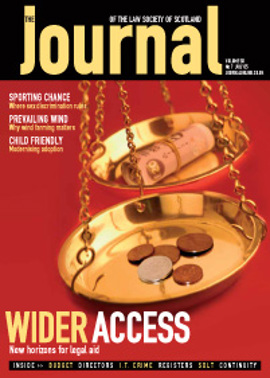Forced marriage: an update
The Forced Marriage etc (Protection and Jurisdiction) (Scotland) Act 2011 has been in operation for a year, and summary applications have been brought in the sheriff court. One, lodged in Glasgow in March, is due to proceed to proof at the end of January 2013. Another action, started in Edinburgh in September, has been sisted for legal aid.
Both have been raised by a local authority, the organisations Hemat Gryffe and Shakti Women’s Aid having also been involved. Each relates to a teenage girl engaged, it is claimed, to a cousin in Asia, and orders are sought against her immediate family, including both parents. I act for a parent in each case. The circumstances are challenging and in the Glasgow case an interpreter is instructed. In one case there are issues of both sexual abuse and mental health. In each action there is an order under s 46 of the Children and Young Persons (Scotland) Act 1937, imposing reporting restrictions. One girl is already subject to a supervision requirement.
Section 1 of the 2011 Act allows the court to “make an order for the purposes of protecting a person... (a) from being forced into a marriage or from any attempt to force the person into a marriage, or (b) who has been forced into a marriage”. “Protecting” here must be synonymous with “preventing”. Paragraph (b) covers a forced marriage that is a fait accompli; probably it should read “purported” marriage. In that regard the Act empowers the sheriff to grant a declarator of nullity. In these two cases the orders sought are preventative.
Section 5 states the test for granting an interim order: that it is “equitable” to grant it having regard to all the circumstances including the “risk of significant harm” if the order is not made immediately. In both cases such orders were granted, and each girl’s passport was surrendered. In the Edinburgh action a motion for recall was refused on a consideration of s 5. (The Forced Marriage (Civil Protection) Act 2007, covering the rest of the UK, allows ex parte orders to be granted where it is “just and convenient” having regard, inter alia, to “any risk of significant harm” if the order is not granted immediately.)
Final orders
The 2011 Act could have been more intelligibly drafted in defining the test for granting a final order. Comparable remedies of an interdictory nature and emanating from the Scottish Parliament are far clearer in that regard: see s 2 of the Protection of Children and Prevention of Sexual Offences (Scotland) Act 2005 (risk of sexual harm order), and s 20 of the Adult Support and Protection (Scotland) Act 2007 (banning order). So is earlier legislation from Westminster covering, e.g., exclusion orders and non-harassment orders. Even the old Lawburrows Act of 1429 (if in modernised form) is simpler.
In the 2011 Act the court is simply directed to “have regard to all the circumstances including the need to secure the health, safety and well-being of the protected person” (s 1(2)). These words also occur in the UK Act of 2007. However, it is equally perplexing to discern a test there for granting a final order.
Different approaches can be observed. In a case from the Northern Ireland High Court, Mr Justice Stephens granted such an order having found that there was a “present real and substantial risk” that the protected persons would be forced to marry, and that an order was a proportionate response with reference to article 8 ECHR (respect for private and family life): [2010] NIFam 6. He was upheld on appeal. In granting an order in a recent English case, Mr Justice Baker found that “the parents intended to force the applicant into marriage, and that there is a very strong likelihood that, unless prevented from doing so, they will force their younger children into marriage as well”: [2012] EWHC 435(Fam). This is consistent with an earlier decision in which a protection order was described as “quasi-injunctive” (Re A [2011] 2 WLR 1027).
It will be immensely helpful to those involved in the field of forced marriage protection to have a Scottish case that has proceeded to a conclusion under the 2011 Act, and that ought to be available soon.
In this issue
- Barriers to sibling contact
- Legal rights, second families and siblingship
- "I'm a chicklet and I live in a hatchery"
- And our survey says...
- No overtaking?
- Reading for pleasure
- Opinion column: Martin Morrow
- Book reviews
- Council profile
- President's column
- 2012: new starts, and challenges
- Independence before the law
- Who do you think they are?
- The expert approach
- Is all publicity good publicity?
- Turning point?
- Young and guilty
- Doubly secure
- Forced marriage: an update
- New age, new image
- A security loophole
- Quit while you're ahead
- When threats are enough
- Practice ground
- Mergers: keeping people onside
- Law reform roundup
- PI Guidelines: new edition
- Ask Ash
- Business radar






